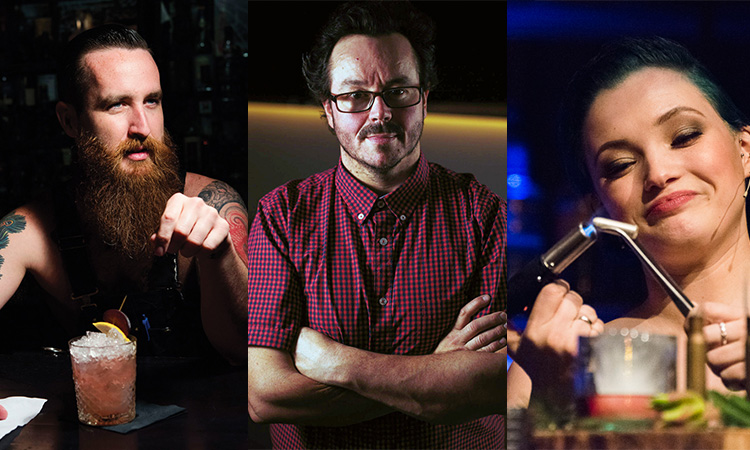Sweetness is an essential component of many cocktails — we spoke to three of the country’s best bartenders about what they do to get the balance right
Sweetness is an essential component of many cocktails — indeed, in the 1806 formulation of just what a cocktail is, sugar is one of the integral elements.
But unlike the bad old days of cocktailing, when every drink that tasted just a little off was dosed with sugar and sent out into the world, these days you might want to be a little more judicious about its use.
“Don’t over do it on the sweetness,” says Charlie Lehmann, bartender and co-owner of Ramblin’ Rascal Tavern.
“Even though Australians still have a very sweet palate, we as an industry will never break free of sweet nectar if we don’t start introducing varied, layered and multiple flavours like sour, bitterness, saltiness, tangs and tarts, piquancy and spice,” he says.
Jenna Hemsworth, who you can find behind the stick at The Baxter Inn and Restaurant Hubert, agrees you don’t want to overdo it.
“But 5mL of sugar syrup in the right place can make all the difference in a cocktail,” she says.
So how do you get the right balance? For Hayden Lambert, bartender and co-owner at Melbourne’s Above Board, it’s about breaking down all the elements of a drink and going from there.
“I approach it very simply: less is more,” he says. “I taste everything separately, and I take small measures of the ingredients and taste all of them. I ask myself what type of drink I’m looking to make. Once I play out what I’m trying to make in my head, then I go about trying to find the balance.”
The simplest of all sweeteners, of course, is the humble sugar syrup. Also known as gomme (if you’re into French), and simple syrup (if you’re into American terminology), it’s the most basic way of introducing sugar to your drink. But the bartenders we spoke to differ on the ratios of sugar to water in the syrup.
“Down at the Rascal we go with the 1:1 ratio,” says Lehmann. “It is the classic way of making your sugar syrup and in my opinion provides the best balance.”
For Lambert and Hemsworth, however, they opt for a more concentrated two parts sugar to one part water ratio.
“At Above Board, we use a homemade 2:1 sugar syrup with gum arabic as a stabiliser,” Lambert says. “It’s currently the only in house ingredient we make. I love it!”
The inclusion of gum arabic acts as a stabiliser, and it also “adds depth and texture to the drinks,” according to Lambert.
The more concentrated dose means that Lambert can use it sparingly in his mixing.
For Hemsworth, the 2:1 ratio is just the way she gets it done.
“I have made all my specs using this ratio and I’ll be damned if I’m changing them,” she says.
Let’s not forget liqueurs
Of course sugar syrup is not the only way to sweeten a drink. Liqueurs have been around for centuries, and many of the proprietary brands have roots that stem from hundreds of years ago. Liqueurs began life as something ostensibly medical in nature; they were a means of delivering the botanicals, roots, herbs and spices that sought to cure what ailed you.
These days we’re a bit more advanced in the medical realm, and liqueurs are primarily about making something taste delicious. And the flavours that they pack mean that you can deliver that touch of sweetness to a cocktail, whilst adding to the taste at the same time.
“Liqueurs are awesome and they are great to experiment with,” says Hemsworth. “They can really add different depths of flavour to a drink when paired well with your other ingredients.”
At Ramblin’ Rascal Tavern, they’ve gone all in on liqueurs, creating their own liqueur program (yep, that just happened).
“We’ve started our liqueur program in response to other fantastic bars doing whisky, gin and rum programs,” Lehmann says. “You gotta give a little love to liqueurs because they provide that touch of sweetness that rounds out your drink. All of them are cognac based so they still provide a little kick and a lot of roundness.”
They’ve named the liqueurs in a distinct Rascal style that is very much their own.
“We started it off with our own version of Alize called Rascal Bleu-lize, then banged out our version of Midori but used rockmelon and called it Big Ol’ Melons. Our latest offering is Rascafe Blend 69, which will replace Kahlua and used in our Es(X)presso Martini’s that are served in take away coffee cups,” he says.
Making their own liqueurs allows them to customise their drinks to that extra degree. “It allows us to stamp our own flavour profiles on the palates of our guests,” Lehmann says.
Liqueurs can open up an array of avenues to wander down, and Hemsworth suggests that you ought not to be afraid of straying from the classic recipes “Just make drinks that are delicious,” she says.


